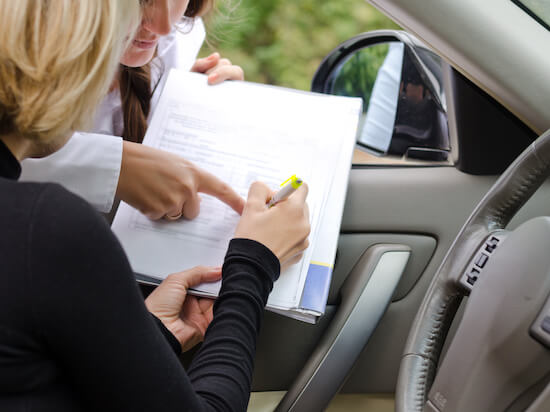Whether you buy your next used vehicle from Craigslist, CarGurus, or AutoTrader, buying from a private seller means you’re doing the paperwork. There’s no dealer to rely on, you’re responsible for getting a new title and registering your car. Typically, you’re just going back and forth with the seller, messaging and emailing online until you both agree to price, terms, and conditions of the delivery.
Use eTags© to Quickly Complete Your DMV Service. Renewals, Title Transfers and More, All Online!

Test driving and looking under the hood
You should still take the necessary steps to protect yourself by test driving, hiring your own mechanic to make sure the car runs efficiently, and pay for it in the way that makes you feel safe. When finalizing the change of car ownership, you can hand over a certified check or money order if you’re not comfortable dealing with big amounts of cash.
Don’t forget the bill of sale (form H-31or write your own) between you the buyer and the seller for proof of purchase and price
The seller must assign thew car title to you
In Connecticut, just like in most states, you want to make sure your private seller has all the necessary paperwork (including car title) to give you along with the vehicle. That’s to ensure you legally own the car and can register it easily with the CT DMV. You want to make sure there’s no lien on it, and that it’s paid in full. Essentially, you don’t want to carry someone else’s debt.

The seller should sign over the CT title to you. This begins the change of car ownership. You must complete form H-13B which is your application for registration and title certificate. The form has various sections dedicated to owner’s information (that’s you the buyer), vehicle info including VIN, model, and so on, plus seller’s info as well. To apply for a new title and claim ownership of the vehicle you purchased, you also need your driver’s license for identification purposes.
Emissions test
All vehicles four model years and older require emissions testing in Connecticut. Typically, this consists of an on-board diagnostic system test which inspect the electronic sensors of the engine and emissions control. If your car is exempt from an emissions test (for instance, if it’s a 2020 model or an all-electric car), you need a VIN inspection.
For vehicles 2007 and older non-diesel vehicles, there’s a pre-condition two-speed idle test to measure tailpipe emissions. All cars are also checked for catalytic converters. If your car requires the PCTSI test, it will also get tested for gas cap pressure leak. Please note that after the car purchase from a private seller, you won’t get a DMV notice in the mail for your emissions testing. Instead, you have 30 days to get your vehicle inspected.

Later on, once it’s already been tested, you’ll get a notice in the mail for your next emissions test 45 days before certificate expires. Once you get your new title and registration, you must get an emissions test every two years. If you fail to do so, the state can block your registration renewal.
Connecticut performs emissions tests on nearly 1.3 million vehicles per year
Registration in Connecticut
You can apply for title transfer and registration at the same time, especially when using private companies like eTags.com. Just make sure to have auto insurance and no outstanding parking tickets or tax payments. Just select CT as your state, click on “transfer your title,” and answer a few questions about the vehicle. With eTags, you can do both title transfer and registration online, from your computer or mobile phone. Your CT license plates and registration card will arrive by mail, right at your doorstep.
SEE ALSO: WHAT CAN PREVENT YOUR VEHICLE REGISTRATION RENEWAL IN CONNECTICUT








